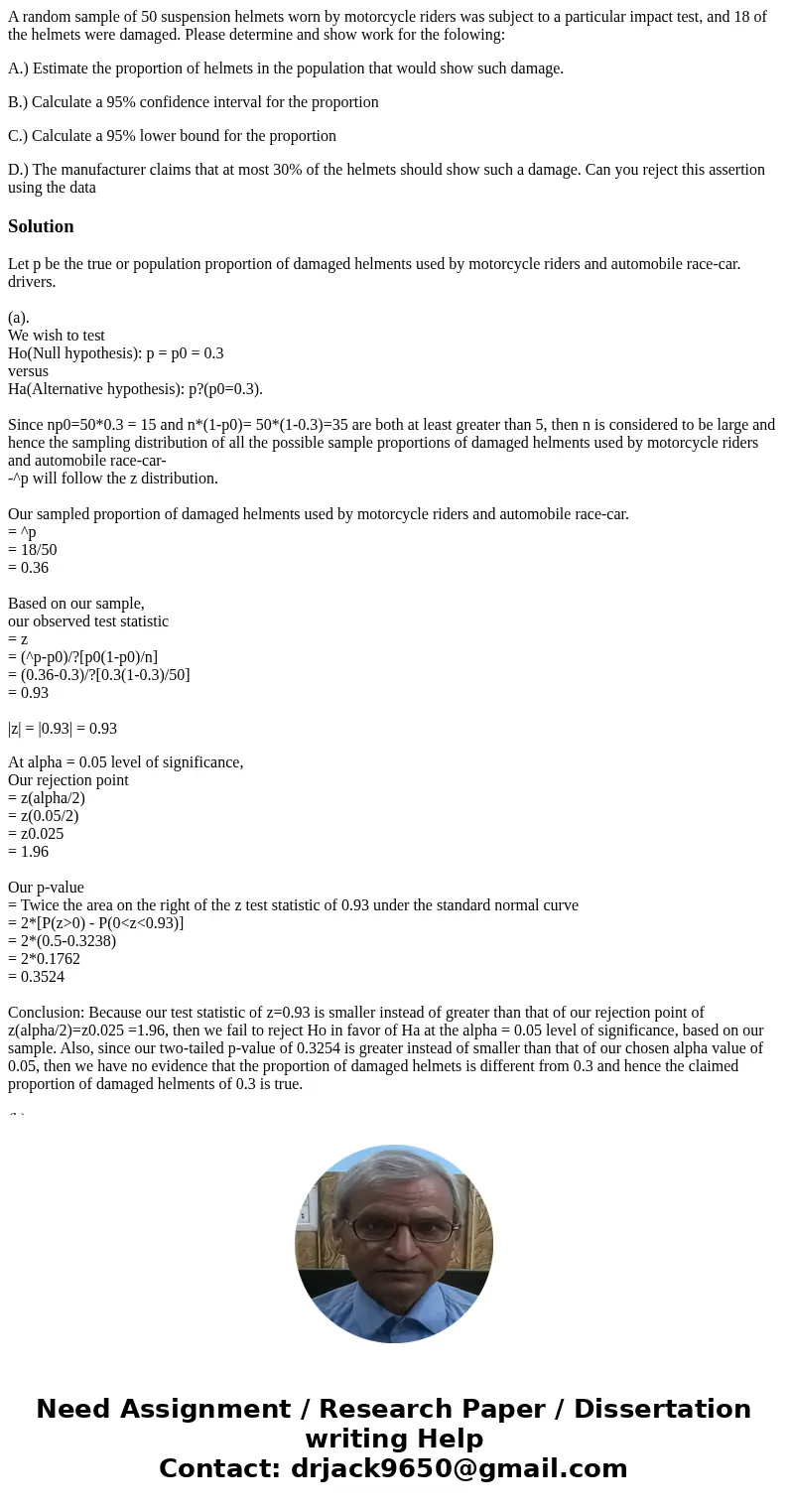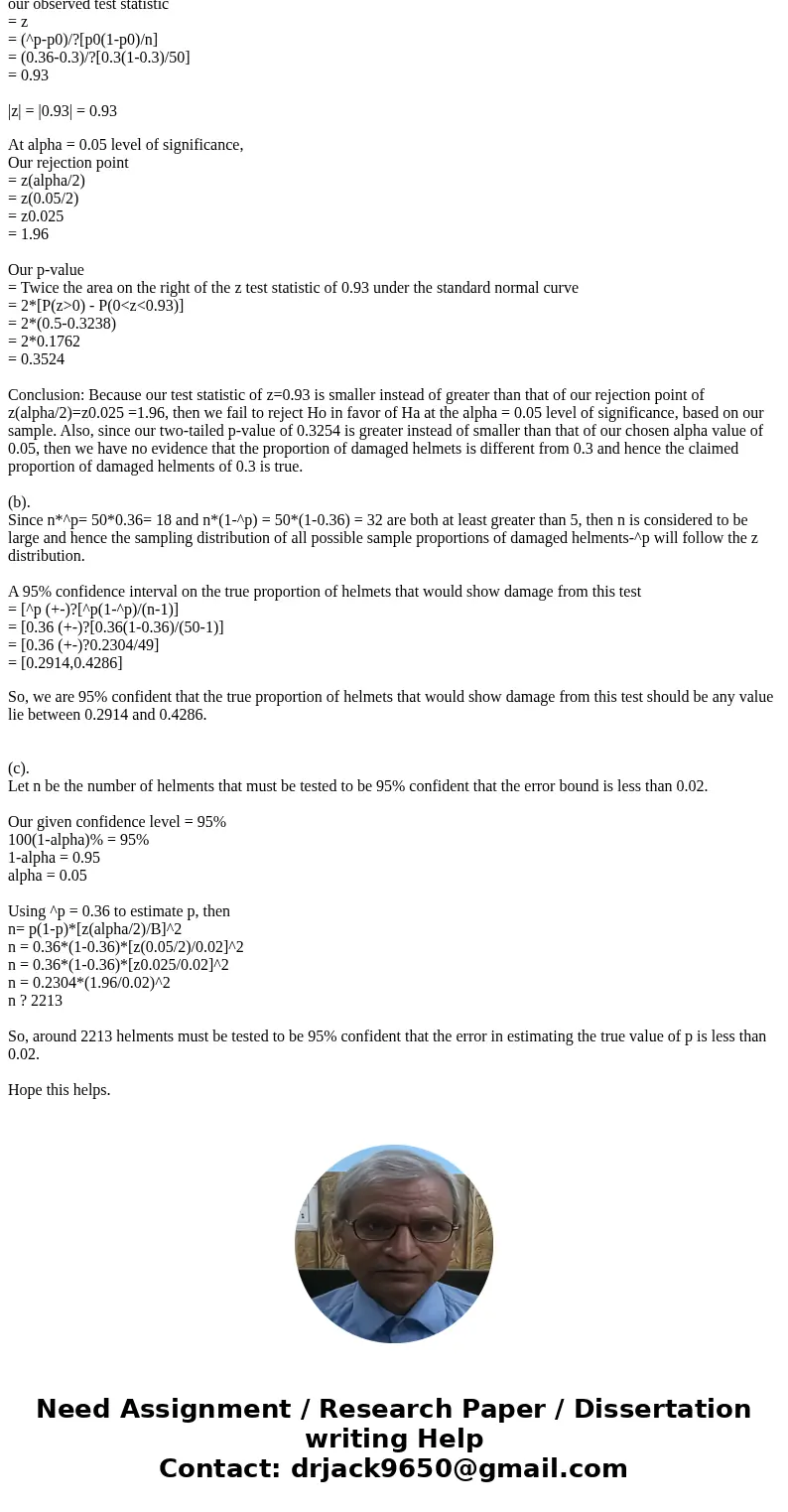A random sample of 50 suspension helmets worn by motorcycle
A random sample of 50 suspension helmets worn by motorcycle riders was subject to a particular impact test, and 18 of the helmets were damaged. Please determine and show work for the folowing:
A.) Estimate the proportion of helmets in the population that would show such damage.
B.) Calculate a 95% confidence interval for the proportion
C.) Calculate a 95% lower bound for the proportion
D.) The manufacturer claims that at most 30% of the helmets should show such a damage. Can you reject this assertion using the data
Solution
Let p be the true or population proportion of damaged helments used by motorcycle riders and automobile race-car.
drivers.
(a).
We wish to test
Ho(Null hypothesis): p = p0 = 0.3
versus
Ha(Alternative hypothesis): p?(p0=0.3).
Since np0=50*0.3 = 15 and n*(1-p0)= 50*(1-0.3)=35 are both at least greater than 5, then n is considered to be large and hence the sampling distribution of all the possible sample proportions of damaged helments used by motorcycle riders and automobile race-car-
-^p will follow the z distribution.
Our sampled proportion of damaged helments used by motorcycle riders and automobile race-car.
= ^p
= 18/50
= 0.36
Based on our sample,
our observed test statistic
= z
= (^p-p0)/?[p0(1-p0)/n]
= (0.36-0.3)/?[0.3(1-0.3)/50]
= 0.93
|z| = |0.93| = 0.93
At alpha = 0.05 level of significance,
Our rejection point
= z(alpha/2)
= z(0.05/2)
= z0.025
= 1.96
Our p-value
= Twice the area on the right of the z test statistic of 0.93 under the standard normal curve
= 2*[P(z>0) - P(0<z<0.93)]
= 2*(0.5-0.3238)
= 2*0.1762
= 0.3524
Conclusion: Because our test statistic of z=0.93 is smaller instead of greater than that of our rejection point of z(alpha/2)=z0.025 =1.96, then we fail to reject Ho in favor of Ha at the alpha = 0.05 level of significance, based on our sample. Also, since our two-tailed p-value of 0.3254 is greater instead of smaller than that of our chosen alpha value of 0.05, then we have no evidence that the proportion of damaged helmets is different from 0.3 and hence the claimed proportion of damaged helments of 0.3 is true.
(b).
Since n*^p= 50*0.36= 18 and n*(1-^p) = 50*(1-0.36) = 32 are both at least greater than 5, then n is considered to be large and hence the sampling distribution of all possible sample proportions of damaged helments-^p will follow the z distribution.
A 95% confidence interval on the true proportion of helmets that would show damage from this test
= [^p (+-)?[^p(1-^p)/(n-1)]
= [0.36 (+-)?[0.36(1-0.36)/(50-1)]
= [0.36 (+-)?0.2304/49]
= [0.2914,0.4286]
So, we are 95% confident that the true proportion of helmets that would show damage from this test should be any value lie between 0.2914 and 0.4286.
(c).
Let n be the number of helments that must be tested to be 95% confident that the error bound is less than 0.02.
Our given confidence level = 95%
100(1-alpha)% = 95%
1-alpha = 0.95
alpha = 0.05
Using ^p = 0.36 to estimate p, then
n= p(1-p)*[z(alpha/2)/B]^2
n = 0.36*(1-0.36)*[z(0.05/2)/0.02]^2
n = 0.36*(1-0.36)*[z0.025/0.02]^2
n = 0.2304*(1.96/0.02)^2
n ? 2213
So, around 2213 helments must be tested to be 95% confident that the error in estimating the true value of p is less than 0.02.
Hope this helps.


 Homework Sourse
Homework Sourse